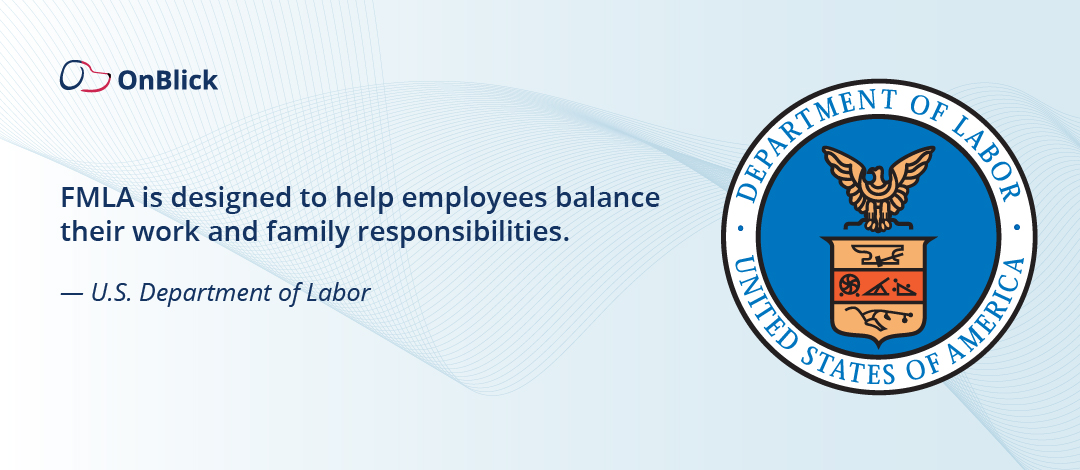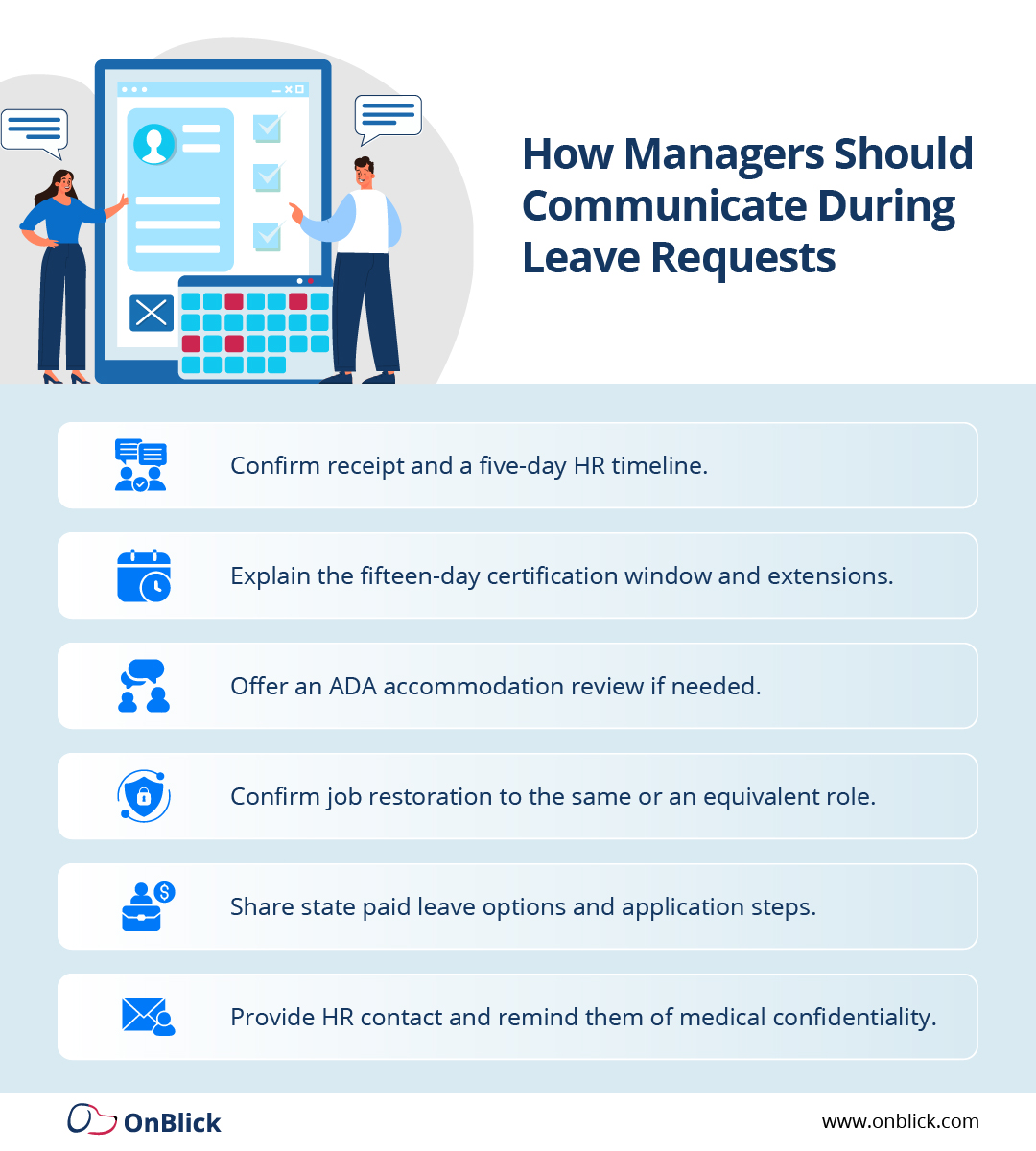Learn More

Leave requests often involve multiple laws at the same time. An employee may be eligible for FMLA, request reasonable accommodation under the ADA, and apply for a state paid leave benefit.
When policies, forms, and timelines are handled separately, errors increase and trust declines. Clear steps, consistent notices, and coordinated reviews reduce risk.
This article outlines a practical approach, one intake process, standard communications, aligned decisions, and documented return to work.
Federal rules stay consistent, but details keep shifting. States continue to update paid family and medical leave programs, benefit amounts, and employer funding rates.
Several states, for example Washington, New York, California, Massachusetts, Oregon, and Colorado, have active programs with annual changes. These updates affect payroll setup, employee notices, and manager guidance.
HR teams must coordinate three tracks at once. Apply FMLA job protection when eligibility is met, continue the ADA interactive process if adjustments are needed, and help employees apply for any state wage-replacement benefits. Clear coordination avoids missed deadlines and conflicting decisions.
Employees and managers often use “leave of absence” as a catch-all phrase, so it helps to be clear about the leave of absence meaning in your policies and conversations. In everyday HR practice, the leave of absence is any approved period when an employee is away from work for a defined reason and timeframe, with an agreed plan for return.
In this sense, it is an umbrella term. It can include legally protected time off (such as FMLA or state family and medical leave), company-approved personal leave that is not required by law, and paid or unpaid periods when the employee steps away from active work. Clarifying which law or policy applies to a specific leave of absence makes it easier to explain job protection, benefits continuation, and how income will be replaced, if at all.

Many HR teams still get basic questions such as “what is FMLA?” or “what is the FMLA meaning in practical terms.” At its core, the Family and Medical Leave Act (FMLA) is a federal law that gives eligible employees job-protected leave for specific family and medical reasons. Health benefits continue during leave on the same terms as active employment. Most employees may take up to 12 workweeks in a 12-month period. Up to 26 workweeks are available for military caregiver leave. Employees must be restored to the same, or a virtually identical, position when leave ends. A clear grasp of FMLA meaning helps HR set the right expectations about job protection, benefits, and documentation from the start.
From a compliance perspective, what is FMLA can be explained through four pillars: eligibility, qualifying reasons, employer notices, and job restoration.
Once “what is FMLA” and “FMLA meaning” are explained in plain language, it becomes easier to coordinate FMLA with other obligations such as ADA accommodations, short term disability benefits, and state paid family and medical leave programs.

The Americans with Disabilities Act (ADA) protects qualified individuals with disabilities from discrimination and requires employers with 15 or more employees to provide reasonable accommodations unless doing so would cause undue hardship. In some situations, time away from work itself can function as a reasonable accommodation, often referred to as an ADA leave of absence.
When leave may be required: If additional time off, beyond any FMLA entitlement or company leave policy, would likely allow the employee to return and perform the essential functions of the job, HR should consider an ADA leave of absence. This can be continuous, intermittent, or a brief extension of a planned return date when medical documentation supports the need.
Interactive process: Managers and HR should engage in a structured conversation with the employee. Clarify the job’s essential functions, request only the medical information needed to understand restrictions, and discuss accommodation options. An ADA leave of absence is one option among several, alongside temporary schedule changes, remote work where feasible, light duty, job restructuring of nonessential tasks, or reassignment to a vacant position.
Undue hardship: If an extended ADA leave of absence or any other accommodation would create significant difficulty or expense, the employer may conclude that option is not reasonable. Hardship must be assessed case by case, considering duration, impact on operations, ability to reassign work, and cost. If one option is not workable, document the reasons and explore alternatives before making a final decision.
Attendance and “no-fault” policies: Rigid attendance or point-based policies should not be applied in a way that ignores legitimate accommodation needs. Approved absences related to disability, including an ADA leave of absence, should be recorded in line with the ADA, and any exceptions should be documented.
Documentation and follow-ups: Keep a dated record of the request, information reviewed, options considered, the decision, and the planned revisit date. If the medical situation changes, reopen the interactive process. Maintain confidentiality of medical information at all times and ensure access to these records is limited to HR and Legal where appropriate.

Employees often ask what is short term disability when they hear about insurance benefits during a medical leave. In simple terms, the answer to what is short term disability is that it is usually an insurance benefit that replaces a portion of an employee’s wages when they cannot work due to a non-work-related illness, injury, or pregnancy-related condition. For HR, clarifying what is short term disability early helps prevent confusion between wage replacement and job protection.
Short-term disability (STD) policies typically define the waiting period before benefits begin, the percentage of pay that will be replaced, the maximum weekly benefit, and how long payments can continue. The benefit itself does not decide whether the job is protected. That part comes from laws such as FMLA or state family and medical leave, or from company policy.
Understanding short term disability vs fmla is essential because they address different needs. FMLA is a federal job-protection law that allows eligible employees to take unpaid, job-protected leave for specific family and medical reasons while maintaining group health coverage. Short-term disability, in contrast, is generally an insurance benefit that pays a percentage of wages when the employee is medically unable to work.
In the short term disability vs fmla conversation, HR should explain that an employee can sometimes receive STD payments and be on FMLA leave at the same time if they meet both sets of requirements. One program provides income, the other provides job protection. A clear short term disability vs fmla explanation should spell out which forms control pay, which control job restoration, and what documentation is required for each so employees and managers understand how the pieces fit together.
Several states pay part of an employee’s wages during family or medical leave. These programs sit alongside job-protection laws; they do not replace them. Use the state benefit for income support, then apply FMLA or a state job-protection law when eligibility is met.
What the benefits look like
Design details vary. New York’s Paid Family Leave pays 67% of average weekly wage up to a published cap, which is $1,177.32 per week in 2025. Massachusetts sets a maximum weekly PFML benefit that updates each year, $1,170.64 in 2025. Washington funds PFML with a statewide payroll premium that resets annually. For 2025, the total premium is 0.92%, with 28.48% paid by employers and 71.52% by employees.
Job protection varies by program
Some states link paid benefits with job protection in the same statute. Oregon provides paid leave and requires job protection after 90 days of employment when the position still exists.
In California, Paid Family Leave is a wage-replacement benefit only. Job protection, when it applies, comes from CFRA or FMLA.
Common reasons covered: Most programs pay for bonding with a new child, caring for a family member with a serious health condition, and the employee’s own serious health need. Many also cover certain military-related events. The U.S. Department of Labor maintains a current map and program links.
What HR should coordinate: Run three tracks at once.
This approach keeps income, job protection, and accommodation duties aligned. For fast reference, use the DOL state PFML page to verify current caps, contribution rates, and covered reasons before each case.

Use a single intake and route the request to all applicable tracks. Designate FMLA if the reason qualifies, continue the ADA interactive process in parallel, and help the employee file for state benefits if available. Confirm whether company PTO will be substituted for unpaid FMLA time, consistent with 29 CFR 825.207 and the latest federal guidance about state benefit coordination.
Keep a clean record. Issue the eligibility and rights notices, track certification deadlines, log ADA discussions, and store state claim confirmations. The paper trail protects both the employee and the organization.


Purpose: Keep one digital folder per leave request, so documents, dates, and decisions are easy to find during reviews or audits.
Folder structure: Create standard subfolders: 01 Intake, 02 Notices, 03 Certification, 04 ADA, 05 State Benefits, 06 Return.
Naming convention: Use a clear pattern, for example: YYYY-MM-DD_Lastname_Firstname_LeaveType_Status. Apply the same pattern to files inside each folder.
Required contents
Timelines and reminders: Set automated reminders for the five-day eligibility notice, the fifteen-day certification window, recertification checkpoints, and the planned return date.
Privacy and access: Mark the folder confidential. Limit access to HR and Legal as needed. Store medical files separately if required by company policy, with a link or reference in the main folder.
Version control: Save updated forms with date stamps, for example WH-382_2025-10-13_signed.pdf. Avoid overwriting originals. Keep an index note listing the latest versions.
Audit trail: Add a one-page log recording what was sent, when, and by whom. Include approvals for any exceptions, such as certification extensions or intermittent schedules.
Monthly quality review: Sample a few files each month. Check for missing notices, late certifications, or unclear ADA notes. Update templates or provide training based on findings.
Common pitfalls to avoid: Missing designation notices, late reminders, incomplete ADA documentation, and mixing medical files with general HR records.

Clear, consistent leave processes protect employees and reduce compliance risk. A single intake channel, timely notices, coordinated FMLA, ADA and state benefit decisions, and a structured return-to-work plan keep cases moving and records ready for review. When expectations, timelines and responsibilities are clear from the start, managers can respond consistently and employees understand the support they can rely on. Strong leave management also shows that the organization takes its obligations under labor laws seriously.
OnBlick’s Leave Management tracks requests, notices, certification dates, and reinstatement in one place. Timesheets sync PTO, unpaid leave, and schedule changes, so balances, payroll, and compliance records stay accurate. Approvals, audit logs, and role-based access keep files clean and review-ready.
For organizations seeking to make leave management a seamless experience, OnBlick provides automation and compliance-ready workflows for requests, notices, tracking, audits, and time capture.
To see how we enhance your HR Compliance, schedule a free OnBlick demo